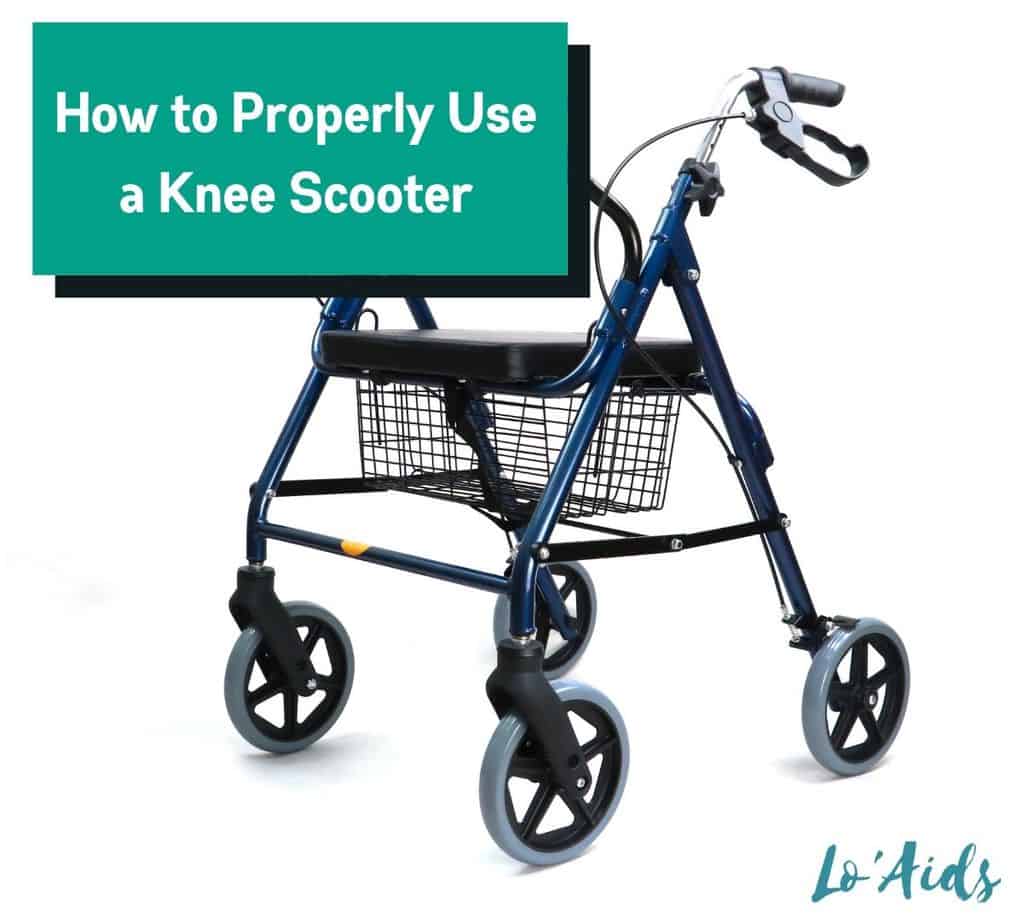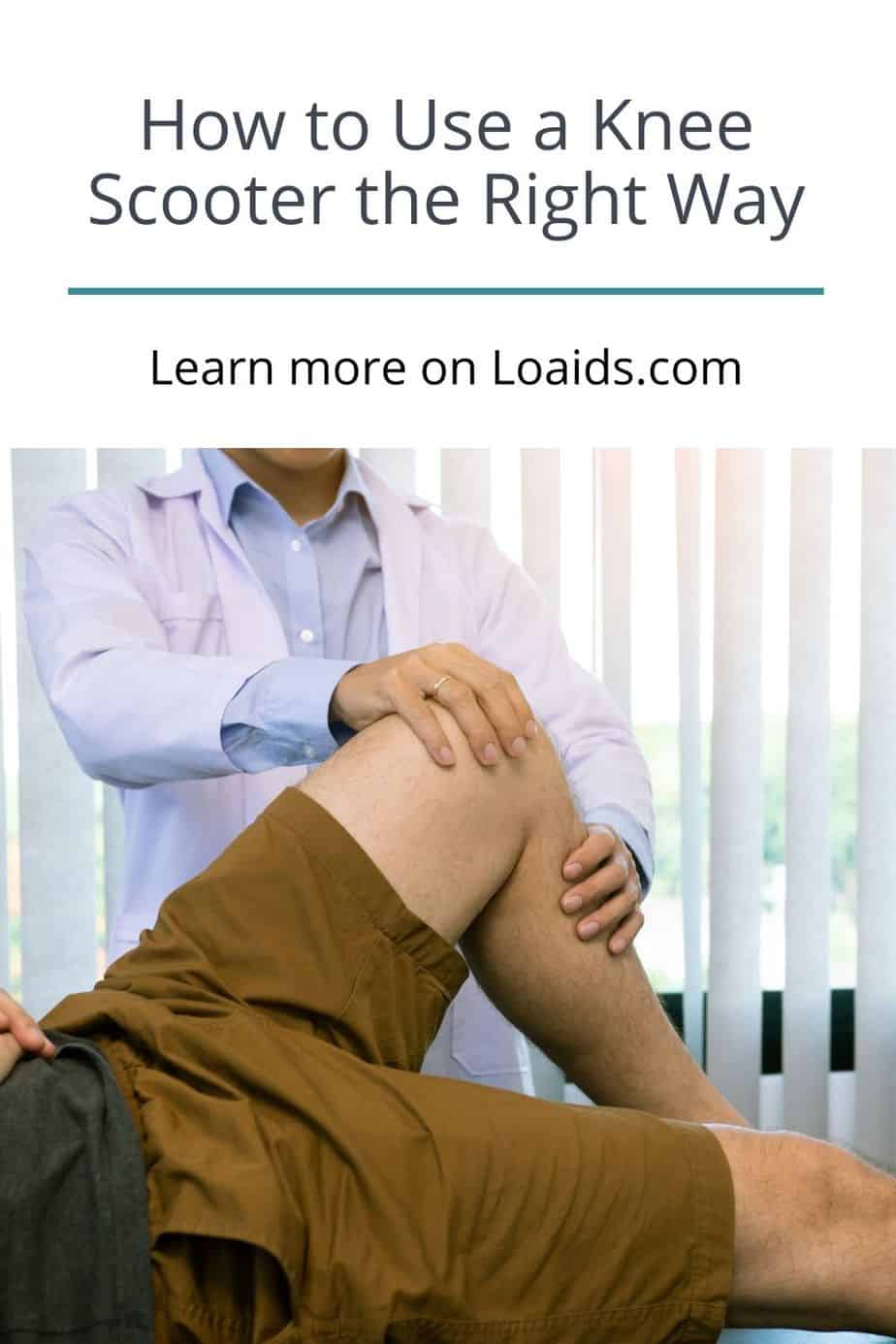Curious about how to use a knee scooter the right way?
Also called knee walkers, these medical mobility aids can help relieve pain and restore motion when there is a below-knee injury.
Of course, they only really work if you actually use them as intended, so below we’re giving you a step-by-step guide to help you do just that.
Let’s get into it!
Don’t forget to also check our rolling knee walker reviews!
Table of Contents
How to Use a Knee Scooter the Right Way
A knee scooter is a perfect option if you are looking for the most convenient and comfortable alternative to crutches.
Let’s be honest, sometimes crutches cause more pain than the actual injury that brought you to them in the first place!
Aboard scooters, you can get around more comfortably, be safer, and have less discomfort overall IF you use them correctly. Fortunately, we list down the steps on how to use a knee scooter in detail.

Knee Scooter Sizing and Preperation
Before you even think about hopping aboard your knee scooter, you need to make sure it’s prepared for YOUR needs.
Most knee scooters enable you to customize the knee pad orientation to meet your specific needs.
It is important to raise the knee rest pad setup and change the handlebars’ height so that you can more easily control the scooter. Otherwise, you could end up hurting yourself even more.
There are no universal answers when it comes to the proper knee pad and steering column height.
I highly suggest getting help from a mobility aids expert. They know exactly what size is right for you and can help you make necessary adjustments.
However, if you’re trying to do it on your own, follow these guidelines:
1. Check the proper orientation of the knee pad.
Some knee pads can be changed to support each leg. First, check the user handbook to see if your scooter’s knee pads need to be angled properly.
If not, skip ahead. Remove the knee rest post from the mainframe by unlocking it. If not, go to the user manual.
2. Measure knee rest height.
First, straighten up and grip onto anything solid. Then, bend your affected knee 90°. Measure from the bent knee to the floor.
After measuring the distance from the ground to your knee, adjust the knee pad’s height to fit. It should be the same height from the knee pad to the floor.
Follow your knee scooter’s user guide or get help from your physical therapist.
3. Modify the handlebars.
The ideal height for handlebars should be the same around your waistline level. You can unlock the handlebar height adjustment knob and can alter the handlebar height properly according to your fit.
To ensure that the scooter is secured, see the user handbook that comes with it. After making necessary adjustments, all that’s left is to mount the device so that it’s ready to use.
READ MORE: What is a Knee Scooter Used for?
Check Stability and Take Your First Step
Ensure your knee scooter stability before taking your first stride. Make sure to follow and double-check the guidelines provided below:
- Your posture should be in an upright position, and you should be standing on your unaffected foot. Avoid a seated position in hunched when using the item model.
- The knee pad should be placed at a 90-degree angle on your affected leg, while your hips should be level. The knee rest pad setup should be positioned where it is most comfortable for you.
- Situate the handlebars in front of your body at around waist height, hold them firmly and then find a comfortable angle position for your arms.
- Consider making the knee pad a cushion, as you’ll need to change the knee rest’s height to accommodate it.
Once your knee scooter is secured, and your brakes are off. You are now in motion.
Push yourself with your strong foot. Take an initial tiny step before taking on a large step. Doing this will allow you to get to know the scooter better.
Make sure you take your first step in a safe area where nothing can fall, tip over, or slip.
I recommend having a friend or caregiver nearby just in case you fall or your scooter tips or slides away from you. It is also crucial to have both hands on the handlebars at all times.
READ MORE: How to Make a Knee Scooter More Comfortable
Make Sure to Follow Safety Protocols
Now that you are slowly getting better at using your knee scooter. There are gentle reminders for you to consider while riding your scooter:
1. Control your speed by using brakes.
You want to go at a controlled speed when utilizing a knee scooter. Slow and manage your present pace by placing weight with your good foot and using hand brakes to slow your momentum.
Every vehicle is unique, like the brakes on an automobile. Not all people are as sensitive as others. Before trusting your braking mechanism, make sure you are familiar with it.
2. Learn to make a proper turn.
Rotate the handlebars to direct the wheels toward your desired destination. You need to know the turning capabilities of your scooter model.
Most versions can turn between 40-45 degrees. If the bends are very tight, you will need to perform a three-point turn (good luck with that!) This will get easier with practice.
3. Properly dismount your knee scooter.
Before getting out of the scooter, always make sure to stop completely. Keep in mind to use your hand brakes as a means of slowing down and afterward using your good foot to bring the vehicle to a complete stop.
It is important to keep your hands on the handlebars while dismounting the vehicle.
Watch this video for a demonstration:
FAQs
Is a knee scooter better than a walker?
A knee scooter is significantly more convenient to use than a leg walker. These scooters glide and help people move, whereas walkers require more body weight including the user’s upper-body strength.
How easy is it to use a knee scooter?
To use a knee scooter, simply lock the hand brakes, grab the handlebars, mount your injured foot on the knee platform rest, free the brakes, and start moving with your unaffected leg.
Conclusion
Assistive features that aid in mobility when one’s knees have been damaged may prevent future injuries, but that does not mean they are without risk.
Make sure you follow the basic safety tips before, during, and after riding your scooter.
References
- csr 1687. 2014. “Knee Walker – Knee Scooter | Knee Surgery: Guide to Knee Walker.” Karman® Wheelchairs. Karmanhealthcare.com. May 16, 2014. https://www.karmanhealthcare.com/knee-walker-knee-scooter/#:~:text=Knee%20scooters%20can%20be%20used%20before%20surgery%20when,are%20having%20surgery%20to%20the%20foot%20or%20ankle..
- Kelly Frey Martin. 2018. “How to Use a Knee Scooter.” Healthpages.org. September 5, 2018. https://www.healthpages.org/health-a-z/how-to-use-a-knee-scooter/.
- “Medicare.” 2019. Medicare & Medicare Advantage Info, Help and Enrollment. August 21, 2019. https://www.medicare.org/articles/does-medicare-cover-knee-scooters/.

If you have more tips on how to use a knee scooter correctly, please share them with us below!





